Hughes Research and Development Laboratories |
||
When I saw this Hughes Research and Development Laboratories employment ad in a 1955 issue of Radio & Television News, I wasn't sure how to take it. The text of the ad makes no reference to the bar graph and the weird drawing. Note the "bottle" is actually a slide rule. The graph can be interpreted to indicate that the more education a person has, the less likely he is to have children. If the typical age of the respondent is in the twenties, then that might reflect how people still in school to earn a higher degree would not be having children. It might also show that people with higher degrees focus more on their careers than on having a family. If you extrapolate the graph backward, does it imply people with an Associate's degree might average 1.5 children, those with just a high school diploma have about 1.7 children, and high school dropouts average maybe 2.0 kids? You have to also assume that most of the people with higher degrees earned them prior to beginning work or else you would have to ask what the Ph.D. with 0.9 kids did with the other 0.5 kids that he had when he only had a Bachelor's degree (1.4 kids)? BTW, that Boolean equation appeared at the top of the ad, but I cannot figure out how it applies. Maybe it was erroneously printed there by the publisher because I could not find any place in the magazine that it might have come from. Hughes Research and Development Laboratories Ad Sidelights of the Scientists Number 1 of a series Scientists and Their Children Some of the young fellows on our staff have been analyzing our files of personal data regarding scientists and engineers here at Hughes. What group characteristics would be found? With additional facts cheerfully contributed by their colleagues they have come up with a score of relationships - some amusing, some quite surprising. We shall chart the most interesting results for you in this series. Results may be to some extent atypical due to California locale. Yet we would surmise that they are fairly representative. Some may well lead to soul-searching: "How am I doing in my chosen field? In my projected career, am I near the point of optimum advancement, or am I just some-where along the way?" If the time should come when a move is indicated in your case, we hope you will give serious consideration to joining the exceptional group at Hughes. In our laboratories here at Hughes, more than half of the engineers and scientists have had one or more years of graduate work, one in four has his Master's, one in 15 his Doctor's. The professional level is being stepped up continually to insure our future success in commercial as well as military work. Data obtained from a 20% random sample of the 2,200 professional engineers and scientists of Hughes Research and Development Laboratories. Security considerations have largely obscured Hughes' pre-eminence as a developer and manufacturer of airborne electronic systems. Hughes is now largest in the field. The Hughes research program is of wide variety and scope. It affords exceptional freedom as well as exceptional facilities. Indeed, it would be hard to find a more exciting and rewarding human climate for a career in science. Our program includes military projects in ground and airborne electronics, guided missiles, automatic control, synthetic intelligence and precision mechanical engineering. Projects of broader commercial and scientific interest include research in semiconductors, electron tubes, digital and analog computation, data handling, navigation, production automation. Right now we have positions for people familiar with transistor and digital computer techniques. Digital computers similar to the successful Hughes airborne fire control computers are being applied by the Ground Systems Department to the information processing and computing functions of the large ground radar weapons control systems. Engineers and physicists with experience in these fields, or with exceptional ability, are invited to send us their qualifications. Scientific Staff Relations Hughes Research and Development Laboratories Culver City, Los Angeles County, Calif.
Posted October 30, 2020 |
||

